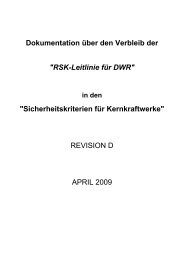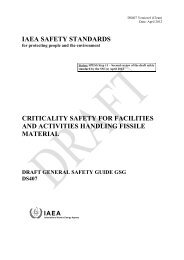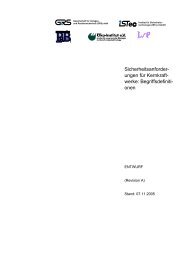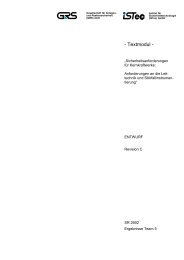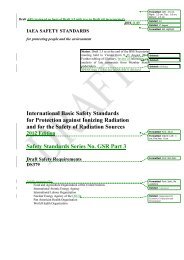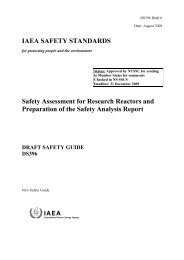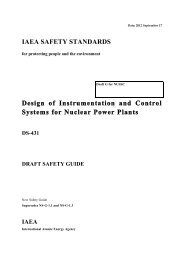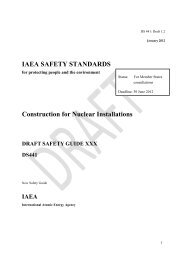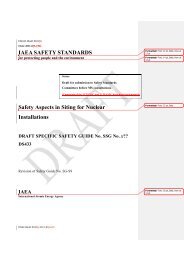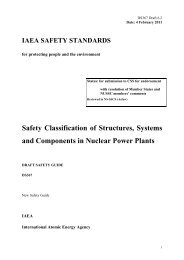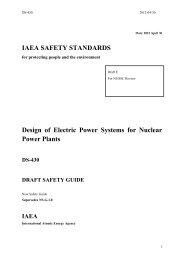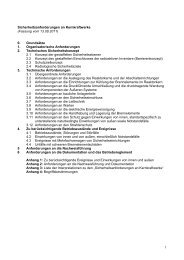Safety Standards Series: Title
Safety Standards Series: Title
Safety Standards Series: Title
Create successful ePaper yourself
Turn your PDF publications into a flip-book with our unique Google optimized e-Paper software.
1 | P a g e 2 4 M a y 2 0 1 2 , r e v 0 - J R JTITLE: DS460 DPP Communication and Consultation with Interested Parties (12 Oct 2011)This table of resolution compiles all comments posted by Member States. These comments are addressed in the order of the content of the DS460 DPP. These commentshave been provided by:1. FRANCE / ASN – NUSSC (10)2. GERMANY / GRS (14)3. JAPAN / NISA – NUSSC (6)4. JAPAN / NISA – WASSC (13)5. UK / ONR (8)6. SOUTH AFRICA – NNR (5)7. US / NRC (30)noParaCOMMENTS BY REVIEWERProposed new textReasonAcceptedAccepted, but modified as followsRESOLUTIONRejectedReason for modification/rejection0. GENERAL COMMENTS1. 1. Japan / NISA - WASSCWe appreciate to challenge this topic. We considerthat this document would cover very wide areas andsensitive issues relating to fundamental subjects suchas justification. We hope that following ourcomments are appropriately addressed and thedocument will be carefully developed.2. 1. UK / ONRThe Office for Nuclear Regulation (ONR) welcomesthis IAEA proposal for a guide on communicationand consultation.ONR aims to be an open and transparent regulatorand is already working towards fulfilling many of therecommendations underpinning this proposal.3. 1. Japan/NISA - NUSCCThe scope of interested party on GS-R-3 is wide. Thescope of interested parties on this safety guide shouldbe specified.4. 2. Japan/NISA - NUSCCBoth “Interested Party” and “Stakeholder” are used inthis DPP. If there is no need to distinguish them, theyshould be unified.Comment only.“Stakeholder” will be replaced by “InterestedParties” in the DPP for clarification purpose.XInterested parties, refer also to asstakeholders, are already defined inthe IAEA <strong>Safety</strong> Glossary.In accordance with the IAEA<strong>Safety</strong> Glossary, stakeholder meansinterested parties which arepreferably used, in line with theGSR part 1 Governmental, Legaland Regulatory Framework for<strong>Safety</strong>.
2 | P a g e 2 4 M a y 2 0 1 2 , r e v 0 - J R JCOMMENTS BY REVIEWERno ParaProposed new text5. 2. Japan / NISA - WASSCEven in this DPP, the terms “interested parties”,“public” and “stakeholder” are mixed.Clarify meaning of these terms and add view on theseterms.6. 1. South Africa / NNRReplace ‟interested parties‟ with ‟interested andaffected parties‟7. 3. US / NRCThe document refers to certain documents that use theterm “Stakeholders” instead of Interested Parties,”(See for example INSAG 20 Report and IAEANuclear Energy <strong>Series</strong> NGT 1.4). We note that theterm “Stakeholders” was defined in IAEA <strong>Safety</strong>Glossary; however, it has been replaced by the term“Interested Parties.” In this context, we recommendthat the DPP address the terminology issueparticularly the relationship between “stakeholders”and “interested parties.”ReasonIAEA <strong>Safety</strong> <strong>Standards</strong> use“interested parties” in accordancewith IAEA <strong>Safety</strong> Glossary. Howeverthe term “stakeholders” is widelyused such as INSAG report. It wouldbe difficult to use only “interestedparties” in this document becauserelevant documents using“stakeholders” would be referred to.Hence some clarification such as themeaning or definition of these termsotherwise the view on theterminology should be added.There may parties that are interestedbut not affected and there may bethose parties that are affected in theprocess.Clarification, consistency, andcompleteness.AcceptedAccepted, but modified as followsRESOLUTION“Stakeholder” will be replaced by “InterestedParties” in the DPP for clarification purpose.“Stakeholder” will be replaced by “InterestedParties” in the DPP for clarification purpose.RejectedXReason for modification/rejectionIn accordance with the IAEA<strong>Safety</strong> Glossary, stakeholder meansinterested parties which arepreferably used, in line with theGSR part 1 Governmental, Legaland Regulatory Framework for<strong>Safety</strong>.This wording is in accordance withthe IAEA <strong>Safety</strong> Glossary.According to the IAEA <strong>Safety</strong>Glossary, stakeholder meansinterested parties. Interested partiesare preferably used, in line with theGSR part 1.
3 | P a g e 2 4 M a y 2 0 1 2 , r e v 0 - J R JCOMMENTS BY REVIEWERno ParaProposed new text8. 5. US / NRCConsider defining openness, transparency, publicinvolvement, consultation, etc. Some of these termsmay be viewed as overlapping. Clear definitions willassist in categorizing the recommended approaches insections 3-6. In a recent U.S open governmentExecutive Order on Open Government, openness hasbeen characterized as having three main components:transparency, participation, and collaboration. Seethe following fordefinitions: http://www.whitehouse.gov/the_press_office/TransparencyandOpenGovernmentYou may also wish to consider the declaration of theInternational Open GovernmentPartnership: http://www.opengovpartnership.org/open-government-declarationFor a fairly exhaustive description of the opennesspolicies, mechanisms, and communications channelsused by the NRC, the agency‟s Open GovernmentPlan may be of interest: http://www.nrc.gov/publicinvolve/open/philosophy/nrc-open-gov-plan.pdf1. IDENTIFICATION9.Doccat1. Germany/GSRDocument Category:either “General <strong>Safety</strong> Guide” or “Specific <strong>Safety</strong>Guide”10.<strong>Title</strong>1. France/ASN - NUSCCChange title to “Regulatory Body‟s Communicationand Consultation with Interested Parties”ReasonClarification regarding the newclassification system for IAEA <strong>Safety</strong><strong>Standards</strong>.AcceptedAccepted, but modified as followsRESOLUTIONSection 6. OVERVIEW, 1 st bullet line will bemodified as follows- Section 1 will be an introduction, whichwill present definitions, the background,objective, scope and structure.General <strong>Safety</strong> GuideThe guide is directed to regulators. Communication and consultation withinterested parties in regulatory activities.RejectedReason for modification/rejectionTransparency and openness areimportant and complex concept.To avoid confusion andmisunderstanding, it has beendecided at this stage (in the DPP)to use them together. Therefore, itis not necessary to define them atthis stage.However, DS 460 will provide inits section 1, with definitions andguidance for transparency,openness and interested partiesinvolvement.The safety guide will be applicablefor all activities and facilities.Requirement 36 of the GSR part 1states “the regulator shall establish(…) provision for effectivemechanisms of communication…”Therefore, it is important to notfocus only on Regulator‟scommunication but to ensure tocover all issues raised byrequirement 36 of GSR part 1 andto broaden the scope to allregulatory activities for safety.
4 | P a g e 2 4 M a y 2 0 1 2 , r e v 0 - J R JCOMMENTS BY REVIEWERno ParaProposed new text11.<strong>Title</strong>1. US / NRCWe suggest modification of the title from“Communication and Consultation with InterestedParties;” to “Communication and Consultation withthe Public and Interested Parties.”ReasonThe intent of the safety guide is tohave a transparent process to involvethe public and interested parties inregulatory analysis (see DPPSection 2, Rationale, Para 2, andSection 4, Para 1, Justification. Inother words, the DPP identified the“The public” and “Interested Parties”as two distinguished groups. Inaddition; GSR Part 1, Governmental,Legal and Regulatory Framework for<strong>Safety</strong>, requests under therequirement 36, “The regulatory bodyshould promote the establishment ofappropriate means of informing andconsulting interested parties and thepublic about the possible radiationrisks and other environmentalinformation associated with facilitiesand activities, and about theprocesses and decisions of theregulatory body.” Further, IAEAGlossary defines “Interested Party as:“A person, company, etc., with aconcern or (especially financial)interest in ensuring the success of anorganization, business, system, etc.”In other words the focus is onperson/organization with financialinterest. Therefore, for consistency,completeness, and to add emphasizeon public involvement, we suggestadding the “the Public” in the title.AcceptedAccepted, but modified as followsRESOLUTIONRejectedXReason for modification/rejectionAccording the IAEA <strong>Safety</strong>Glossary, the interested parties,refer also to as stakeholders,include the public and thosesegments of it, including the peopleresiding in the vicinity of facilitiesand activities.
no5 | P a g e 2 4 M a y 2 0 1 2 , r e v 0 - J R JPara12.Doccat13.ProposedactionCOMMENTS BY REVIEWERProposed new text2. US / NRCUnder Section 1 (Identification) DS460 wasidentified under category of “<strong>Safety</strong> Guide.”However, under Section 5, page 3, it was stated “Thisnew guidance is expected to constitute a chapter inthe new structure of the set of <strong>Safety</strong> Guides. Inaddition, the footnote on page 3 stated: “By 2016 ifthe comprehensive guide on regulatory control is notavailable, the document might be published as aTECDOC or safety report.” Therefore, the IAEASecretariat needs to clearly identify if the currentdocument is a “<strong>Safety</strong> Guide” intended to illustrateimplementation of “<strong>Safety</strong> Requirements” orotherwise.2’. US / NRC EditorialNew document to create complete and coherentguidance to communicate and involve regardingcommunication and involvement of the public andinterested parties in the regulatory activities in atransparent and open manner.2. BACKGROUND / RATIONALE14.19. US / NRCOver the last decades, there has been a growingsocietal awareness about the necessity fortransparency, openness and involvement of interestedparties in the regulation of nuclear energy and otheruses of radioactive material safety-related activities.15.12. UK / ONR„…interested parties in nuclear safety-relatedactivities.‟RESOLUTIONReasonAcceRejectAccepted, but modified as followsptededReason for modification/rejectionPurpose and Clarity The footnote on page 3 will be deleted The intention is definitively topublish a safety guide.EditorialThe phrase “safety-related” has aspecific use in nuclear installations asdefined in the IAEA <strong>Safety</strong> Glossary.The new General <strong>Safety</strong> Guide for“Communication and Consultationwith Interested Parties” is applicableto all facilities and activities andshould be broader in scope andcontext, and not limited to “safetyrelatedactivities.”Current text simply states the safetyrelatedactivities rather thanspecifying nuclear.New document to create complete andcoherent regarding communication andinvolvement of the public and other interestedparties in regulatory activities in a transparentand open manner.in the safety-related issues.XInterested parties include thepublic according the IAEA <strong>Safety</strong>Glossary.In compliance with the SF 1 <strong>Safety</strong>Fundamentals and according to theIAEA <strong>Safety</strong> Glossary, “‘<strong>Safety</strong>’includes the safety of nuclearinstallations, radiation safety, thesafety of radioactive wastemanagement and safety in thetransport of radioactive material.”In compliance with the SF 1 <strong>Safety</strong>Fundamentals and according to theIAEA <strong>Safety</strong> Glossary, “‘<strong>Safety</strong>’includes the safety of nuclearinstallations, radiation safety, thesafety of radioactive wastemanagement and safety in thetransport of radioactive material.”
6 | P a g e 2 4 M a y 2 0 1 2 , r e v 0 - J R JCOMMENTS BY REVIEWERno ParaProposed new text16.13. UK / ONR„Research suggests that knowledge of the nuclearindustry and how it is regulated is low but there is adegree of uncertainty about the topic given itscomplexity and perceived risk associated with nuclearenergy.‟17.13’. US / NRC EditorialThey have usually little Members of the publicusually have limited knowledge, but a great deal ofconcern and uncertainty in about any issue involvingradiation because of the complexity of this topic, andthe perceived risk associated with nuclear energy andthe use of ionizing radiation sources.18.12. South Africa / NNRThey have usually little knowledge but and a greatdeal of uncertainty19.14’. US / NRC EditorialMost people, who are dependent on informationprovided by regulatory bodies, operatingorganizations, experts, and communicated by thenews media, request want to have access to reliable,comprehensive, and easily understood informationabout safety and regulatory issues to form theiropinion. They also request want to have fair andreasonable possibilities opportunities to provide theirviews and influence regulatory decision-making.20.13. South Africa / NNRThey also request to have fair and reasonablepossibilities opportunities to provide their views andto influence regulatory decision-making processes.21.2.2. Germany/GSR2 nd para, 1 st sentence:“Beyond the legitimate interest of the public andother interested parties in radiation and nuclear safetymatters, it is recognized that safety issues are besthandled with …”22.25’. US NRC editorialIt is recognized that safety issues…23.26’. US NRC editorialThere are several rationales for being to betransparent and, open, and to involve for involvingthe public..ReasonRather than simply stating there islittle knowledge, reference research.Editorial and clarityEditorial.EditorialThe word „opportunities‟ is moreappropriate.Editorial.EditorialEditorialAcceptedXXXXXXAccepted, but modified as followsRESOLUTIONMembers of the public usually have limitedknowledge and a great deal of concern anduncertainty about any issue involving radiationbecause of the complexity of this topic, andthe perceived risk associated with nuclearenergy and the use of ionizing radiationsources.RejectedXReason for modification/rejectionThe scope includes all facilitiesand activities, and not only nuclearindustry.See the resolution of the commentno 3‟ of US NRC.See clarification proposed bySouth Africa (Comment no 2).
7 | P a g e 2 4 M a y 2 0 1 2 , r e v 0 - J R JCOMMENTS BY REVIEWERno ParaProposed new text24.23. Japan / NISA - WASSCThere are several rationales to be transparent, openand to involve the public and interested parties inregulatory activities: competence, integrity andimpartiality can be established.25.2 / 1 stbullet26.2 / /1 stbullet27.2 / 2 ndbullet7’. US NRC editorialIndependence: being under scrutiny make any undueinfluences, that might adversely affect safety, morevisible and therefore enhances the ability of aregulatory body to make independent judgments anddecisions.4. UK / ONR„Being more open and transparent will allow theregulator to effectively demonstrate itsindependence.‟9. US NRCCredibility and legitimacy: transparent and opencommunication about regulatory decision-making andopportunities for public involvement in that processreinforces reinforce the public‟s and interestedparties‟ awareness of the role and responsibility of theregulatory body for protecting the public and theenvironment from the harmful effects of ionizingradiation and helps to inform the public about how itdischarges its duties. The promoter is concerned by Incontrast to promotional organizations concerned withpublic acceptance of nuclear energy as such, theregulatory body is concerned only promotes withpromoting safety through its regulatory activities. Useof a transparent and open regulatory decision-makingprocess helps to demonstrate and reinforce thisdistinction.ReasonWe would like to confirm thissentence means as follows:It is essential for regulatory bodies tobe able to develop and implement astrategy and a culture of transparencyand openness and to involve whennecessary stakeholders so that trust inits independence, quality andregulatory control stability.EditorialCurrent text needs furtherexplanation, as it is difficult tofollow.Parallel structure and clarityAcceptedXXAccepted, but modified as followsRESOLUTIONBeing more open and transparent will allowthe regulator to effectively demonstrate itsindependence. Moreover, transparency andopenness make any undue influences morevisible and therefore enhances the ability of aregulatory body to make its decisionsindependently.RejectedXReason for modification/rejectionActually, there are two differentissues. The 2 nd paragraph providesrationales to be transparent, openand to involve interested partieswhereas the penultimate paragraphof this section states a nonexhaustivelist of characteristics ofa regulator to be recognized as atrustable organization.The focus is not to demonstrate itsindependence but to make itsdecision making more visible inorder to make more difficult tounduly influence the regulatoryprocesses.
no8 | P a g e 2 4 M a y 2 0 1 2 , r e v 0 - J R JPara28.2 / 2 ndbullet29.2 / 4 thbullet30.2 / 4 thbullet31.2 / 4 thbulletCOMMENTS BY REVIEWERProposed new text4. Japan / NISA - WASSCCredibility… the regulatory body and relevantauthorities promote safety through regulatoryactivities5. Japan / NISA - WASSCRegulatory control stability:2. France/ASN - NUSCC- stability: public involvement strengthens thelegitimacy of regulatory decisions (even though somestakeholders may not always agree with a decision)and provides a broader responsibility for them, whichalso increases the regulatory control stability overtime. Furthermore, the public and interested partiesinvolvement decreases the likelihood of narrow earlyframing which later shows up to be insufficient. Eventhough some stakeholders may not always agree witha decision, if there is trust and respect they will acceptthe integrity of the decision making process.1’. US / NRC EditorialSection 2, page 132.48’. US / NRC EditorialThe Fukushima accident has reinforced the necessityof for the…33.43. Japan/NISA - NUSCCThe Fukushima Dai-ichi Nuclear Power Stationaccident.34.45. UK / ONRRemove „concerned‟ from „communicate effectivelywith the concerned public’35.46. UK / ONR„When developing emergency arrangements, there isalso a need for an open and transparent dialogue toensure relevance and to enhance the knowledge ofpeople living near facilities and activities in order tobetter prepare for a crisis situation.‟ReasonRegulatory bodies conduct theirregulatory activities based on thelegislation, and safety as a concern isrestricted by legislation.Thus the regulatory bodies may notnecessarily conduct their regulatoryactivities only for the promotion ofsafety. The organization promotingsafety may be in the legislativebodies.ClarificationClarificationToo much optimisticFourth Bullet: Change the word“stability,” to “Stability.”EditorialExact namingCommunication is required to thepublic at large, not just those who are„concerned‟.„…to dialogue in a transparent andopen manner‟ is difficult to read.AcceptedXXXXXXAccepted, but modified as followsRESOLUTION…even though some interested parties may notalways agree with a decision…RejectedXReason for modification/rejectionAs described in the IAEA <strong>Safety</strong>Glossary and addressed in the GSRpart 1, a regulatory body is anauthority or a system of authorities(…).Use of interested parties instead ofstakeholders.
9 | P a g e 2 4 M a y 2 0 1 2 , r e v 0 - J R JCOMMENTS BY REVIEWERno ParaProposed new text36.410. US NRCWhen developing emergency arrangements, there isalso a need to dialogue with local authorities in atransparent and open manner to ensure their relevancethe effectiveness of the arrangements and to37.59’. US / NRCHence it is essential for a regulatory body bodies tobe able to develop and implement a strategy and aculture of transparency and openness and to involvestakeholders when necessary stakeholders appropriateso that trust in it‟s the regulatory body‟s competence,integrity, and impartiality can be established. Thisstrategy and this culture should be based on proactivepublic information dissemination and awillingness to a real for meaningful publicparticipation. They The strategy and culture shouldalso take account of some information disclosurewhich incorporate approaches for preventing thedisclosure of information that may be restrictedbecause of, for instance, security issues, commercialconfidentiality, or intellectual property rights.38.510’. US / NRC Editorial…a relevant strategy to be transparent, opened and toinvolve the Public anad Interested Parties in theRegulatory Activities.that is directly relevant totransparency, openness, and public involvement.39.53. France/ASN - NUSCCHence it is essential for regulatory bodies to be ableto develop and implement a strategy and a culture oftransparency and openness and to involve whennecessary stakeholders so that trust in its competence,integrity and impartiality can be increasedestablished.40.57. UK / ONR„…to involve the public and interested parties inregulatory activities.‟ClarityEditorialReasonAcceptedAccepted, but modified as followsRESOLUTIONWhen developing emergency arrangements,there is also a need for an open and transparentdialogue to ensure the effectiveness of thearrangements and to enhance the knowledge ofpeople living near facilities and activities inorder to better prepare for a crisis situation.Hence it is essential for a regulatory body todevelop and implement a strategy and aculture of transparency and openness and toinvolve interested parties when appropriate sothat trust in the regulatory body‟s competence,integrity, and impartiality can be established.This strategy and this culture should be basedon pro-active public informationdissemination and a willingness formeaningful public participation. The strategyand culture should also incorporateapproaches for preventing the disclosure ofinformation that may be restricted because of,for instance, security issues, commercialconfidentiality, or intellectual property rights.RejectedReason for modification/rejectionSee comment 6 from UK /ONR.It may be useful to involve peopleresiding in the vicinity and notonly local authorities.“Stakeholder” will be replaced by“Interested Parties” in the DPP forclarification purpose (See US /NRC comment no 3 and others).Editorial X Proposal considered in section 4(See comment 3‟ from SouthAfrica / NNR).Established may be too strongChange from upper to lower case.XX
10 | P a g e 2 4 M a y 2 0 1 2 , r e v 0 - J R JCOMMENTS BY REVIEWERno ParaProposed new text41.63’. South Africa / NNRThe existing scattered information in several safetyguides does not provide the regulatory bodies withclear and comprehensive guidance to develop andimplement a relevant strategy to be transparent,opened and to involve the Public and InterestedParties in the Regulatory Activities. This issue hasbeen raised by several Member States, includingduring IRRS missions.3. OBJECTIVE42.14. US / NRCThe DPP did not include a “Scope” Section. In thiscontext, the document should explain if the scope willinclude illustration of the process to enhance publicinvolvement particularly for new entrants to nuclearindustry. For example, in certain countries, theprocess of public involvement and participation innuclear safety regulatory activity may not be welldeveloped and the public may have limitedbackground to comprehend safety aspects and issues.Therefore, the process may involve significantinvestment in resources, training, and public mediaadvertisement and interaction to encourage publicparticipation. The scope of the document shouldexplain if it involves process development to enhancepublic participation.43.111’. US NRC editorialThe objective of this guide is to provide practicalguidance, good best practices, and recommendationsfor nuclear safety regulatory bodies for seeking toinstitute open and transparent processes ofcommunication processes and meaningfulconsultation of interested parties in regulatoryactivities.ReasonThis information is repeated insection 4.Completeness, clarity, andimplementation aspects.EditorialAcceptedXAccepted, but modified as followsRESOLUTIONThe sections 3. OBJECTIVE and 6.OVERVIEW will be modified for clarificationand completeness purpose (See comment no 6from „Japan/NISA – WASCC‟ and commentno 6 of „France/ASN‟)The objective of this guide is to providepractical guidance, good practices andrecommendations for regulatory bodiesconcerning communication and consultationwith interested parties about the possibleradiation risks associated with facilities andactivities, and about processes and decisionsof the regulatory body.The safety guide will not addresscommunication during crisis situation.RejectedReason for modification/rejectionThe DDP is based on the lastversion of IAEA template whichdoes not include the scope section.DS460 will be a general safetyguide for all regulatory bodiesproviding guidance for all aspectsof “normal” communication andconsultation that will includeprocess to enhance interestedparties awareness and involvement.The intention is to provide furtherguidance and recommendations onhow to comply with the safetyrequirement 36 of the GSR part 1“Governmental, Legal andRegulatory Framework for <strong>Safety</strong>”.Therefore, it is proposed to clarifythe objective in accordance withrequirement 36.
11 | P a g e 2 4 M a y 2 0 1 2 , r e v 0 - J R JCOMMENTS BY REVIEWERno ParaProposed new text44.14. South Africa / NNRThe objective of this guide is to provide practicalguidance, good practices and recommendations forradiation and nuclear safety to regulatory bodies foropen45.16. Japan / NISA – WASSCThe objective of this guide is to provide practicalguidance, good practices and recommendations forstakeholder engagement in such regulatory activitiesas for radiation and nuclear safety regulatory bodiesfor open and transparent processes of communicationand consultation of interested parties in regulatoryactivities. These activities include: drafting regulationand legislation, inspection and enforcement,licensing, review and assessment and other specificactivities performed by or under the responsibility ofthe regulatory body46.17. France/ASN - NUSCCIn section 1, the various “interested parties” may bedescribed.EditorialClarificationReasonClarification(Local resident, professionalassociations, patients, standardorganizations, licensees, NGO, TSO,governmental agencies/ministries(either national or local), neighboringcountries, foreign counterparts,journalists, Members of theParliament, teachers/professors,…AcceptedAccepted, but modified as followsRESOLUTIONThe objective of this guide is to providepractical guidance, good practices andrecommendations for regulatory bodiesconcerning communication and consultationwith interested parties about the possibleradiation risks associated with facilities andactivities, and about processes and decisionsof the regulatory body.The safety guide will not addresscommunication during crisis situation.The objective of this guide is to providepractical guidance, good practices andrecommendations for regulatory bodiesconcerning communication and consultationwith interested parties about the possibleradiation risks associated with facilities andactivities, and about processes and decisionsof the regulatory body.The safety guide will not addresscommunication during crisis situation.RejectedXReason for modification/rejectionConsidering other comments, theobjective is modified in accordancewith requirement 36 of the GSRpart 1.The intention is to provide furtherguidance and recommendations onhow to comply with the safetyrequirement 36 of the GSR part 1“Governmental, Legal andRegulatory Framework for <strong>Safety</strong>”.Therefore, it is proposed to clarifythe objective in accordance withthe aforesaid requirement.The definition is already providedby the IAEA <strong>Safety</strong> Glossary.As necessary, further explanationwill be provided by DS460.
12 | P a g e 2 4 M a y 2 0 1 2 , r e v 0 - J R JCOMMENTS BY REVIEWERno ParaProposed new text47.17. Japan / NISA - WASSCDrafting regulation and legislation, inspection andenforcement, licensing, review and, assessment(including periodic processes (1) ), and emergencyresponse (2) and other specific activities performed byor under the responsibility of the regulatory body(e.g., communication on events or activities in othercountries, assistance and support) (3) .48.14. France/ASN - NUSCCThese activities include: drafting regulation andlegislation, inspection and enforcement, licensing,review and assessment, emergency management(preparedness and response) and other specificactivities performed by or under the responsibility ofthe regulatory body (e.g., communication on eventsor activities in other countries, assistance andsupport).49.14. Japan/NISA - NUSCCSpecify the meaning of “communication on events oractivities in other countries”.4. JUSTIFICATION50.112’. US NRC editorial…under the requirement 3651.18. Japan/NISA – WASSC“The regulatory body should shall promote theestablishment …52.213’. US NRC editorialMoreover, basic aspects to communicate and consultof communication and consultation with the public…Reason(1) Periodic and iterative process ofcommunication is a key issue for thelong-term usage of nuclear energyand ionizing radiation sources,especially for waste management, andshould be emphasized in this guide.(2) Although the previous chapterrefers the necessity of regulatorybody for communication inemergency situations, this issue is notmentioned in this section.(3) Clarification.The meanings in the parenthesis arevague, and communication amongdifferent states about emergencyresponse should be described in thisDPP.To explicitly address communicationrelated to emergency managementClarificationEditorialEditorial error.EditorialAcceptedXXXAccepted, but modified as followsRESOLUTIONThe objective of this guide is to providepractical guidance, good practices andrecommendations for regulatory bodiesconcerning communication and consultationwith interested parties about the possibleradiation risks associated with facilities andactivities, and about processes and decisionsof the regulatory body.The safety guide will not addresscommunication during crisis situation.The objective of this guide is to providepractical guidance, good practices andrecommendations for regulatory bodiesconcerning communication and consultationwith interested parties about the possibleradiation risks associated with facilities andactivities, and about processes and decisionsof the regulatory body.The safety guide will not addresscommunication during crisis situation.RejectedXReason for modification/rejectionThe intention is to provide furtherguidance and recommendations onhow to comply with the safetyrequirement 36 of the GSR part 1“Governmental, Legal andRegulatory Framework for <strong>Safety</strong>”.Therefore, it is proposed to clarifythe objective in accordance withthe aforesaid requirement.The safety guide will not addresscommunication during crisissituation covered by other IAEApublications.The intention is to provide furtherguidance and recommendations onhow to comply with requirement36 of the GSR part 1“Governmental, Legal andRegulatory Framework for <strong>Safety</strong>”.It is proposed to clarify theobjective accordingly.
13 | P a g e 2 4 M a y 2 0 1 2 , r e v 0 - J R JCOMMENTS BY REVIEWERno ParaProposed new text53.23. Germany/GSR2 nd para, 1 st sentence:“Moreover, basic aspects to communicate and consultwith the public and interested parties are set out inseveral safety guides for instancein the Specific <strong>Safety</strong> Guides, for instance in SSG-12,Licensing Process for Nuclear Installations (SSG-12),paragraphs 2.42 to 2.45, and SSG-16, Establishingthe <strong>Safety</strong> Infrastructure for a Nuclear PowerProgramme, paragraphs 2.84 to 2.96.”54.34. Germany/GSRlast sentence:“However the existing aforesaid guidance, scatteredbetween several safety standards and guides, isinsufficient to provide Member States with clear andcomprehensive guidelines …”ReasonSSG-16 addresses the topicstransparency and openness asessential elements of the safetyinfrastructure.Editorial.5. PLACE IN THE OVERALL STRUCTURE OF THE RELEVANT SERIES55.111. US NRCThe DPP stated: “This new guidance is expected toconstitute a chapter in the new structure of the set of<strong>Safety</strong> Guides1 which will optimize their number aswell as to review their comprehensiveness.”It is unclear what is meant by “optimize theirnumber.” Is increasing the number of safety guides isan optimization process? Please explain. In addition,how DS460 will review comprehensiveness of thesafety guides or their structure.…will optimize (reduce?) their number as well as toreview enhance their comprehensiveness56.25. Germany/GSR2 nd reference: “The convention on Assistance in thecase of a Nuclear Accident or RadiologicalEmergency …”57.26. Germany/GSR3 rd reference: “The convention of on the PhysicalProtection of Nuclear Material …”58.27. Germany/GSR4 th reference: replace <strong>Safety</strong> <strong>Series</strong> No. 115 by GSRPart 3Clarification and correctness of thestatements.Correct title.Correct title.The new International Basic <strong>Safety</strong><strong>Standards</strong> (GSR Part 3, InterimEdition) were published in November2011.AcceptedXXXXXXAccepted, but modified as followsRESOLUTIONRejectedReason for modification/rejection
14 | P a g e 2 4 M a y 2 0 1 2 , r e v 0 - J R JCOMMENTS BY REVIEWERno ParaProposed new text59.28. Germany/GSR5 th reference:“All valid <strong>Safety</strong> Requirements of the series NS-Rxx,WS-R-xx, TS-R-xx and WS-G-xx in addition TS-R-1, WS-R-5, SSR-5 and GSR Part 5;”60.29. Germany/GSR13 th reference:“Method for Developing Arrangements for Responseto a Nuclear or Radiological Emergency (EPR-Method2003) …”61.210. Germany/GSR13 th reference: citation of IAEA-TECDOC-953should be moved to the following subsection “Otherpublications”62.211. Germany/GSRAdd new reference: “Specific <strong>Safety</strong> Guide,Establishing the <strong>Safety</strong> Infrastructure for a NuclearPower Programme, SSG-16”63.212. Germany/GSR2 nd reference: “IAEA Nuclear Energy <strong>Series</strong> … (NG-T-1.4)”64.213. Germany/GSRAdd new reference: “IAEA Nuclear Energy <strong>Series</strong>,An Overview of Stakeholder Involvement inDecommissioning (NW-T-2.5)”65.214. Germany/GSRAdd new reference: “IAEA <strong>Safety</strong> Reports <strong>Series</strong>No. 24, Communication planning by the nuclearregulatory body”ReasonThe series WS-G-xx encompasses<strong>Safety</strong> Guides, not <strong>Safety</strong>Requirements.The TS-R-xx series contains onlydocument (TS-R-1).The only remaining valid documentof the WS-R-xx series is WS-R-5,because: SSR-5 has replaced WS-R-1 andWS-R-4, GSR Part 5 has superseded WS-R-2, GSR Part 3 has superseded WS-R-3.Correct title.IAEA Technical Documents areusually not considered as IAEA<strong>Safety</strong> <strong>Standards</strong>.SSG-16 addresses the topicstransparency and openness asessential elements of the safetyinfrastructure (see paragraphs 2.84 to2.96).Editorial.Another relevant document(published in 2009) that needs to betaken into account and checked forconsistency during drafting.This <strong>Safety</strong> Report (published in2002) describes good practices andprovides examples of how theregulatory body can establish asystematic and structured programmefor enhancing effectivecommunication with various partiesand under various circumstances.AcceptedXXXXXXXAccepted, but modified as followsRESOLUTIONRejectedReason for modification/rejection
15 | P a g e 2 4 M a y 2 0 1 2 , r e v 0 - J R JCOMMENTS BY REVIEWERno ParaProposed new textReason66.29. Japan/NISA – WASSCAs for the documents to be taken into account in thisdraft, the following issues should be considered. (1) Editorial error.(1) All <strong>Safety</strong> Requirements of the series NS-R-xx, Specific <strong>Safety</strong> Requirements areWS-R-xx, TS-R-xx, and WRS-RG-xx, GSR and dropped.SSR.BSS was revised.(2) Following requirements and guides relating to the (2) This document should also bewaste management or the nuclear emergency should taken into account of safetybe includedrequirements and guides relating toGSR Part5; GS-G-3.3 ; GS-G-3.4waste area or the nuclear emergency.SSR-5; SSG-14 ; SSG-1; DS355WS-G-xx series and GSG-267.25. France/ASN - NUSCC What about nuclear security seriespublications?6. OVERVIEW68.114’. US NRC editorialThis document will establish guidance for regulatorybodies on communication and consultation withInterested Parties in a transparent and open manner induring the conduct of their the Regulatory Activities.It will provide information on the considerations foreffective communication and interaction with theseparties topics that should be considered tocommunicate and interact effectively with them andalso on how to….69.18. UK / ONR„This document will establish guidance for radiationand nuclear safety regulatory bodies oncommunication and consultation with interestedparties in a transparent and open manner. It willprovide information of the topics that should beconsidered to communicate and interact effectivelyand also how to manage information which may notbe disclosed because of confidentiality, security orother reasons.‟70.110. Japan/NISA – WASSCIt will provide information on the topics that shouldbe considered to communicate and interact effectivelywith them and also how to manage information whichmay be not disclosed because of confidentiality (e.g.security, safeguards) or others reasons.EditorialChange from upper to lower casewhere necessary and some other textchanges for clarity.Clarification of the meaning ofconfidentiality.AcceptedXXXAccepted, but modified as followsRESOLUTIONAll valid and relevant <strong>Safety</strong> Requirements ofthe series GS- R-xx, NS-R-xx and SSR-xx inaddition TS-R-1, WS-R-5, and GSR Part 5RejectedXReason for modification/rejection(1) WS-R-xx series includes onlyWS-R-5. Indeed,- SSR-5 has replaced WS-R-1 andWS-R-4,- GSR Part 5 has superseded WS-R-2,- GSR Part 3 also has supersededWS-R-3.(2) Documents are not directlyrelevant for the topicThe intention is to provideguidance related to the requirement36 of the GSR part 1. It will alsoaddress restricted informationbecause of, e.g., security issues.
16 | P a g e 2 4 M a y 2 0 1 2 , r e v 0 - J R JCOMMENTS BY REVIEWERno ParaProposed new textReason71.16. France/ASN - NUSCC A more detailed table of content forthe guide would help having a betteridea of its content, especially forthose having to draft it…AcceptedAccepted, but modified as followsRESOLUTIONSection 1 will be an introduction, which willpresent definitions, the background…Section 2 will provide overarchingrecommendations which (…) requirements.For instance, the following issues should beaddressed:- Responsibility of the regulatory body;- Interaction with interested parties shouldnot lead to compromise safety and callthe regulator‟s independence in thequestion;- Need for the regulator to be a trustedorganizations;- Graded approach; and- Principles on restricted information.Section 3 will present the provisions thatshould be considered for inclusion in the legaland regulatory framework and will provideguidance which should be followed whenestablishing the legal and regulatoryframework for communication andconsultation with interested parties;Section 4 will describe the arrangements,including policy and procedures, that shouldbe (…) for effective implementation. It willalso address the elements which should beconsidered when developing andimplementing communication andconsultation processes such as objective,targeted parties, context, legal and regulatoryrequirements. At last, it will provide guidanceon evaluation and improvement of theeffectiveness of communication andconsultation strategy.Section 5 will provide guidance:- About methods to effectively informinterested parties and will discuss themost effective communication channelsto use; and- On how to consult effectively interestedparties and, when appropriate, toimplement collaborative processes withrelevant interested parties.RejectedReason for modification/rejectionThe current table of contentprovides a relevant skeleton toaddress all issue raised byrequirement 36 of the GSR part 1.However, for better understanding,further information is proposed tobe included in the DPP even ifAs proposed by France/ASN –NUSSC (Comment no 10),sections 5 and 6 are merged.
17 | P a g e 2 4 M a y 2 0 1 2 , r e v 0 - J R JCOMMENTS BY REVIEWERno ParaProposed new text72.16. US / NRCSections 1-6 are summarized at such a high level thatit is difficult to fully understand the types of contentthat are planned for inclusion. For example, whatvehicles will be used to promote “openness” and howwill technology be discussed in the document?73.112. Japan/NISA – WASSCThe order of the discussion might be inadequate. Inprinciple, guidance (Section 3 and 4) is discussedafter provisions (Section 5 and 6) were implemented74.1 /8. France/ASN – NUSCCbullet1 In section 1, it should be reminded that the regulatoris not the only one which interacts with interestedparties. The licensees role should be recalled, even ifnot within the scope of the guide75.1 /bullet276.1 /bullet377.1 /bullet312. US / NRCSection 2 will provide basic (overarching?)recommendations which that should be applied tomeet the relevant safety requirements.15’. US / NRC editorialSection 3 will present the provisions which thatshould be considered for being part of inclusion inthe legal and regulatory framework for …6. Japan/NISA - NUSCCSection 3 will present the provisions which should beconsidered being part of the legal and regulatoryframework for transparency, openness andinvolvement of interested parties in regulatoryactivities.ReasonAcceptedAccepted, but modified as followsRESOLUTIONSee resolution of comment no 6. France/ ASN– NUSCC.RejectedReason for modification/rejectionFurther information is proposed tobe included in the DPP.Clarification X See clarification to resolve thecomment no 6 of France/ASN –NUSCC.Seems ambiguous. Content of thissection is not clearly distinguishedfrom the content of the followingsections. Suggest giving an exampleor two. Also suggest defining theelements of openness used in thesubsequent sections, e.g.,transparency, participation, andcollaborationXXThis issue is considered in section2 BACKGROUND, in paragraph1.See clarification to resolve thecomment no 6 of France/ASN –NUSCC.Editorial X See clarification to resolve thecomment no 6 of France/ASN –NUSCC.It is not necessary to legislate fortransparency, openness andinvolvement of interested parties inregulatory activities because there aredifferences in legal systems of eachcountry.Section 3 will present the provisions thatshould be considered for inclusion in the legaland regulatory framework and will provideguidance which should be followed whenestablishing the legal and regulatoryframework for communication andconsultation with interested parties.In accordance with Handbook onNuclear Law, paragraph 2.3.1, thefollowing should be legallyaddressed: (z) To establishappropriate mechanisms andprocedures for informing andconsulting the public and otherstakeholders about the regulatoryprocess...The 3 rd bullet point will bemodified, as proposed by US NRC(See 15‟. US NRC) and theHandbook on Nuclear Law will beadded in Section 5.
no18 | P a g e 2 4 M a y 2 0 1 2 , r e v 0 - J R JPara78.1 /bullet479.1 /bullet480.1 /bullet481.1 /bullet4COMMENTS BY REVIEWERProposed new text9. France/ASN - NUSCCSection 4 content should be expanded to be clearer onthe topics covered :“Section 4 will describe the provisions which shouldbe developed and implemented by the regulatorybody for communication and consultation withinterested parties. This will include culture,leadership and management system for effectiveimplementation.4.1 General recommendations4.2 Involvement of interested parties in draftinglegislation, regulations or regulatory guidancedocuments4.3 Involvement of interested parties in licensing aspecific facility or activity,4.4 Involvement of interested parties in inspectionand enforcement drafting regulation and legislation,4.5 Involvement of interested parties in emergencypreparedness activities and during/following an actualemergency4.6 Keeping interested parties aware of safetysignificant events occurring at facilities and activities(INES…) and significant safety issues4.7 Involvement of interested parties in otheractivities performed by the regulatory body4.8 Documenting the above mentioned involvementsin the Regulatory Body management system13. US / NRCSection 4 will describe the policy and proceduresprovisions which that should be developed andimplemented… This will include culture, leadership,and management systems for effectiveimplementation.11. Japan/NISA – WASSCThis will include culture, leadership and managementsystem for effective implementation. This documentneeds to describe the framework of the provisionwhich should be developed and implemented forcommunication and consultation with interestedparties.7. US / NRCSuggestion for Additional ContentReasonTo be consistent with §3.While the word “provisions” seemsappropriate for the Section 3 on thelegal and regulatory framework,suggest using something morespecific than provisions here.All the provisions for communicationand consultation with interestedparties are not developed by theregulatory body.Consider addressing guidance forusing measures to determine theeffectiveness of the opennessprogram.AcceptedAccepted, but modified as followsRESOLUTIONSection 4 will describe the arrangements,including policy and procedures, that shouldbe… This will include culture, leadership, andmanagement system for effectiveimplementation…Section 4: …It will provide guidance on evaluation andimprovement of the effectiveness ofcommunication and consultation strategy.RejectedXXReason for modification/rejectionThere is no definite way tocommunicate. Communication andconsultation strategy is very muchdepending on legal and regulatoryrequirements but also otherparameters.In section 4, guidance will beprovided on how to develop andimplement strategy and plan forcommunication and consultationconsidering the communicationobjective, targeted parties,sensitivity of the issue, etc.However, examples will beprovided as necessary.A proper implementation of aprocess needs also other„arrangements‟ (tools, agreements,etc.).Only one management system isdeveloped by the regulator.Section 4 will provide guidance fordeveloping the internalarrangements of regulatory body.See also clarification provided bythe resolution 71 (6. France/ASN –NUSCC).The improvement mechanismshould be part of the managementsystem.
no19 | P a g e 2 4 M a y 2 0 1 2 , r e v 0 - J R JPara82.1 /bullet483.1 /bullet584.1 /bullet685.1 /bullets5 and6COMMENTS BY REVIEWERProposed new text13. Japan/NISA – WASSCAdd some texts explaining the specific characteristicsof communication and consultation with interestedparties depending on thematic issues such as thoseunder emergency situation (such as Fukushima),under planned situation (siting, construction,decommissioning etc.), and existing situation.16’ US NRC editorialSection 5 will provide guidance about methods toinform effectively inform the public and interestedparties and about discusses the most effective majorcommunications channels to use which should beused.17’ US NRC editorialSection 6 will provide guidance on how to consulteffectively with … and, when necessary appropriate,to implement collaborative processes with relevantstakeholders.10. France/ASN - NUSCCSections 5 and 6 could be merged as they seems todeals with means of involving interested parties,which could be used to implement actionsrecommended in §2 to §486.15. Japan/NISA - NUSCCIf the information, which may be not disclosedbecause of confidentiality, security or other reasons,is related to both section 5 and 6, an additionalsection for such topic is better to be provided.ReasonAlthough the description of thisoverview is deemed to be generic,this DPP as a whole seems to putemphasis on the issues in accidentalcondition. Communication andconsultation with interested partiesmay be somewhat different for theother issues such as siting of thedisposal facility for radioactivewaste. Hence some detaileddescription is helpful to understandthe document.Editorial and clarityEditorial and tone. “Necessary”suggests that the regulatory bodywould only consult when “required”rather at its discretion.It is important to provide guidancehow to manage the informationwhich may be not disclosed.AcceptedXXAccepted, but modified as followsRESOLUTIONSection 4 will describe the arrangements,including policy and procedures, that shouldbe developed and implemented by theregulatory body (…). This will include culture,leadership and management system foreffective implementation. It will also addressthe elements which should be considered andaddressed when developing and implementingany communication process such as objective,targeted parties, context and regulatoryrequirements.Section 5 will provide guidance:- About methods to effectively informinterested parties and will discuss themost effective communication channelsto use; and- On how to consult effectively interestedparties and, when appropriate, toimplement collaborative processes withrelevant interested parties.RejectedXReason for modification/rejectionThe safety guide will not addresscrisis communication.Proposal based on other commentsprovided by the Member States.Relevant guidance andrecommendations will be providedin the relevant sections




